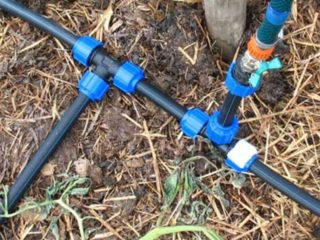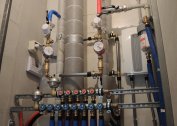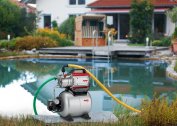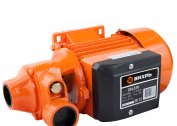If you do not organize a decent level of water supply on the plot, the outcome of the battle for the crop will be immediately predetermined. You can water the beds from buckets, but this is a tremendous work and a lot of time spent. Thanks to a wide range of plastic pipes and parts, you can make a summer water pipe from HDPE with your own hands.
Features of the device of summer water supply in the country
Summer water supply in the country from polypropylene pipes has one indisputable advantage - low cost. But the advantages of synthetic material do not end there. Another significant plus - you do not need to worry about measures to prevent freezing of water with the advent of cold weather, there is no need to dig construction materials deep into trenches, and insulate areas located on the surface in different ways.
As a rule, at the design stage, two options for installing water supply are considered.
Collapsible or open water supply
This is the easiest way to install water supply in the country, the pipes are located on the surface of the soil. The implementation of the project requires a minimum of financial and physical investments, but also has disadvantages. The main ones are:
- With the end of the summer season, the whole system must be disassembled and stored in a dry, warm place, and with the advent of spring, reassemble.
- If there are no owners on the site for a long time, the water supply can be stolen.
- The pipeline laid on top makes it difficult to move around the site.
Plastic pipes and parts are easily damaged by sharp objects.
Concealed or permanent water supply
To lay the water supply system, small trenches are dug, several points of water intake should go to the surface. It has much more advantages compared to the previous installation method.
Permanent water supply does not need annual installation and dismantling. They are almost impossible to steal, but during the design and installation it will take more effort and time.
Pipes must be laid with a slight slope, this will drain the water without much effort before the onset of cold weather.
Necessary tools and materials
 To install a reliable summer water supply system, you need to use the following tools and materials:
To install a reliable summer water supply system, you need to use the following tools and materials:
- Devices designed to automate irrigation, as a rule, are soil moisture sensors or a timer.
- The union for connection of the crane and hoses. On the one hand, it is equipped with a "ruff", which is inserted into the pipe, and on the other, a spring grip.
- Watering and sprinkling heads.
- Sprayers and watering guns that are equipped with couplings. When changing nozzles of watering equipment, they shut off the water supply automatically.
- Special equipment designed to organize drip irrigation.
If there is no connection to the central water main in the country or home plot, wells and boreholes are used as a source of water. Depending on the depth of the source, an additional submersible or surface pump must be installed.
Preparatory work and installation steps
The scheme of the water supply network on the plot will depend on whether the pipeline is installed - permanent or collapsible.
Do-it-yourself last option is much easier. It consists of hoses that are made of silicone or plastic, and bonding parts made of plastic, plastic or steel.Using special high-quality connections, you can create a dock that will not leak.
Most often, water pipes are made of polypropylene pipes, which are inclined relative to the source of water supply. The inclination to the drain valve should be approximately 8-15 degrees. If the water supply system is stationary, it is best to place it in trenches of small depth, and bring several irrigation taps to the surface.
Before proceeding with the installation, you need to prepare a drawing so that it is easier to calculate how much material is required. At this design stage, you need to calculate the number and size of pipes, other tools and materials.
After marking, you can start digging a trench. Its optimum depth is 0.4 meters, with the exception of cases when pipes are laid under the beds.
Watering can be done using an irrigation system or hose. At the junction of the pipeline and the central highway, a valve or inlet valve is mounted. Pipes made of low-pressure polyethylene are connected to the inlet valve with a sleeve. It is located on the outside and inside - it depends on the location of the thread. After fixing the connection, mount a piece of pipe with a hose and a tee.
For fastening in the pipe coupling, you need to cut it with a hacksaw or knife. Hoses are also connected to the water supply using couplings (it is preferable to use quick-detachable structures).
Pipe bending
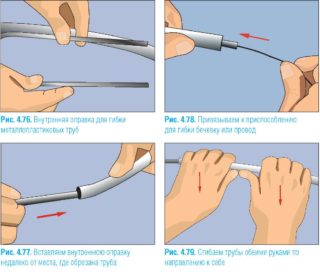 When installing a summer water supply system in a country house, it is important to know in what ways pipes can be bent so as not to violate their integrity.
When installing a summer water supply system in a country house, it is important to know in what ways pipes can be bent so as not to violate their integrity.
- To implement the bend, you will need several plugs that are filled with sand. This method minimizes the formation of breaks. Alternatively, you can use wooden choppers, not stubs. Pipes are made of different strengths, so it’s hard to say how much effort will have to be made. The simplest method of bending is to insert another, but with a small cross-section into the pipe, find the stop and give it the desired shape, exerting a physical effect.
- Pipes of square shape and large diameter are bent using a burner and sand.
- For aluminum and steel pipes, a burner is also needed. The product is covered with sand and plugs are placed on both sides. The required area is heated red and bent.
If used improperly, the burner may leave a hole in the building material, therefore it is recommended that it be routed regularly to the side.
How to manually bend pipes
In order to independently bend pipes made of metal plastic, you must strictly follow the following recommendations:
- Bend slowly and without sudden movements.
- To get the required angle of inclination, it is necessary to lay pieces of wire before bending.
- The larger the lever of the pipe worn on the structure, the easier it is to bend it.
To bend polypropylene pipes, heat the required area with a hairdryer to 150 degrees. The segment with the thickest wall is bent. They also bend the building material without preheating, but then the maximum angle of inclination will be 8 degrees. Before filling the system with water, check the pipes for defects and damage.
The summer water supply system in the country can be designed and installed independently, you just need to familiarize yourself with the basic stages of installation and the rules for laying pipes.
